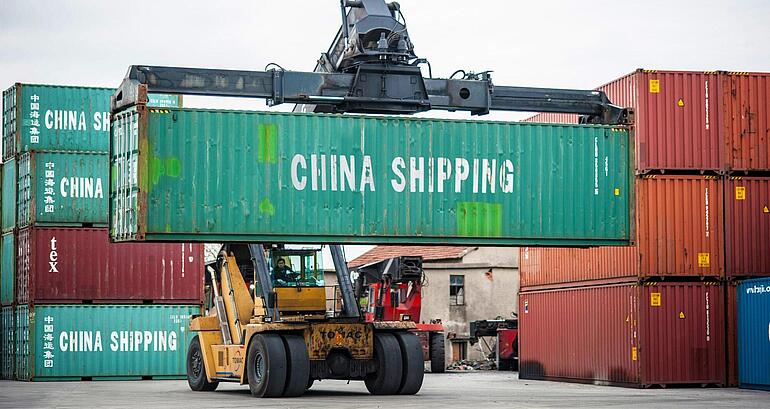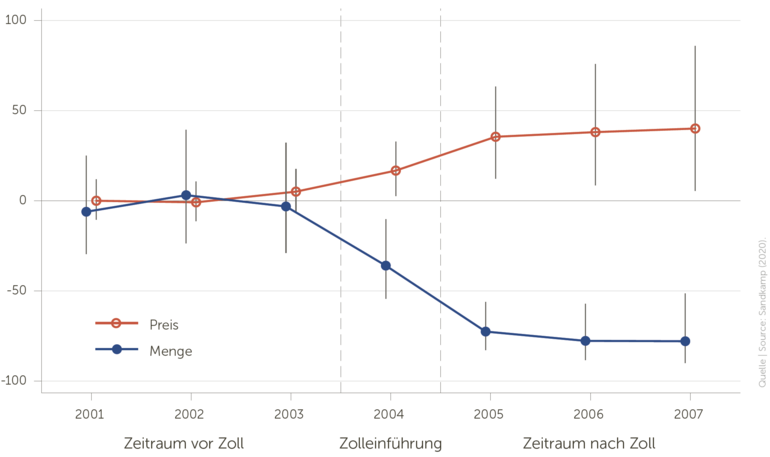Kiel Institute Highlights
EU Antidumping duties against China - Reduce trade barriers, fight inflation
When it comes to protectionism in trade policy, it is often the U.S. with its “America First” slogan, China, or both together that are pilloried (see the Sino-American trade war). But the European Union (EU) also frequently uses trade protection instruments, especially against China. Taking the 2004 EU enlargement as a natural experiment one can show that EU antidumping duties (AD duties) are significant trade barriers, which have stronger negative effects on prosperity than previously thought. This finding is interesting not least with regard to the current debate on inflation.

AD duties are the most commonly used trade defense instrument. 51 percent (61 cases) of all EU antidumping duties in force were directed against China in 2019 (Garcia-Herrero et al., 2020). China has long been treated differently from other countries in the EU’s AD regulations because of its non-market economy status (NMES). Market economy status (MES) is assigned by the importing country to the exporting country and determines how AD duties are calculated. Exporters in MES countries pay company-specific duties, while AD duties against NMES countries are often the same for all exporting companies and on average higher than the duties imposed against MES exporters. In 2017, the EU officially abandoned the NMES concept, while the U.S. continues to treat China as a non-market economy.
The 2004 EU enlargement can be used as a natural experiment to study the impact of these AD duties. To do this, data on import prices and volumes at the product level for the ten countries that joined the EU in 2004 (Eurostat, 2017) were combined with information on AD duties (Bown, 2015). When they joined the EU in 2004, the new member states adopted the AD duties imposed by the European Union against third countries. Assuming that the decision to join the EU was not motivated by their AD policies, enlargement led to an imposition of AD duties in the accession countries that was independent of their existing trade flows.
Effect of AD duties on import prices and quantities

EU accession (beginning of treatment) in May 2004. Percentage change in import prices and quantities of treated products on vertical axis, year on horizontal axis. The plot shows point estimates with 95 percent confidence intervals, indicating large and significant price and quantity effects of AD duties since their introduction in 2004.
Price pressure from antidumping duties
Using data for 2003 and 2005, the estimates show that AD duties increased pre-duty import prices by an average of 25 percent. Prices of imports from exporters not subject to duties also increased. These results are important in light of the recent increase in producer prices seen across the EU.
Since AD duties are often levied on intermediate products, a reduction or elimination of these duties could ease price pressures somewhat. AD duties are most prevalent in the metals and chemicals sectors. 48 percent (23 percent) of EU AD cases in force in 2019 were imposed in the metals (chemicals) sector (Bown, 2020). Notably, for EU AD duties against China, the average ad valorem duties in these sectors exceed 30 percent (Yalcin et al., 2016). In July 2021, metals and chemicals were among the sectors where producer prices increased the most (in the EU 27: by 33.9 percent for basic metals and fabricated metal products and 19.3 percent for chemicals compared with July 2020; Eurostat, 2021), suggesting that the elimination of duties could help stabilize prices in these sectors.
Prices up, quantities down
These positive price effects were only observed for imports from MES countries. The pre-duty prices of imports from NMES countries remained constant. This still implies rising post-duty prices, since the duties are fully passed on to importers, but the overall effect is smaller. Paradoxically, dropping NMES from the EU AD legislation in 2017 may have contributed to a larger increase in import prices after the imposition of AD duties. On the other hand, this effect is offset by lower average duties imposed against MES exporters.
Import volumes decreased by 74 percent on average. Due to the higher average duties imposed by the EU against NMES exporters, imports from these countries decreased more (by 85 percent on average) than imports from countries with MES (68 percent). Thus, the fact that the EU no longer uses the NMES category might be expected to reduce the trade-dampening effects of AD duties. However, the new methodology recognizes the concept of price and cost distortions, which could ultimately lead to China being treated the same as before (Garcia-Herrero et al., 2020).
Removal of trade barriers could reduce inflationary pressure
The figure illustrates the impact of EU AD duties on trade over time by showing the estimated effects before and after enlargement in 2004. The estimated price and quantity coefficients are not statistically significant before the start of treatment. Positive (negative) price (quantity) effects can be observed at the time of accession. These increased in 2005 and remained relatively constant until the end of the sample period in 2007. This suggests persistent effects of AD duties. While the removal of AD duties may not directly reduce pre-duty prices, it should definitely reduce post-duty prices.
Overall, the research presented sheds new light on the actual trade-dampening effects of AD duties. EU AD duties are significant trade barriers that greatly reduce imports. The estimated coefficients are larger than those previously found in the literature, suggesting stronger negative welfare effects than previously thought. The trade-destructive effect of AD duties on imports from China and other exporters with NMES is particularly strong. On the other hand, price effects (before duty) are not seen for these countries, while they are positive for MES exporters. The elimination of anti-dumping duties could therefore reduce the current pressure on input and consumer prices in the EU, especially in the metals and chemicals industries. Finally, the EU’s recent abandonment of the NMES approach, if fully implemented, can be expected to have an impact on the eff ectiveness of its AD policy. In particular, the MES concept may lead to an increase in pre-duty prices. After all, this is the official objective of the instrument, although a further price increase is certainly not desirable given the current environment.
Related publication
References:
Bown, C.P. (2015, 2020). Global Antidumping Database. The World Bank.
Eurostat (2021). Producer Prices in Industry, Domestic Market – Monthly Data.
Eurostat (2017). Eurostat COMEXT Database.
Felbermayr, G., und A. Sandkamp (2021). Antidumpingzölle, Preise und China: Freihandel als Retter in der Not? WIFO Research Brief 12/2021.
Garcia-Herrero, A., et al. (2020). EU-China Trade and Investment Relations in Challenging Times. European Parliament.
Sandkamp, A. (2020). The Trade Effects of Antidumping Duties: Evidence From the 2004 EU Enlargement. Journal of International Economics 123.
Yalcin, E., A. Sandkamp und P. Lang (2016). Reformen der EU-Handelsschutz-Instrumente. Unter Berücksichtigung des Marktwirtschaftsstatus der Volksrepublik China. Bertelsmann Stiftung.